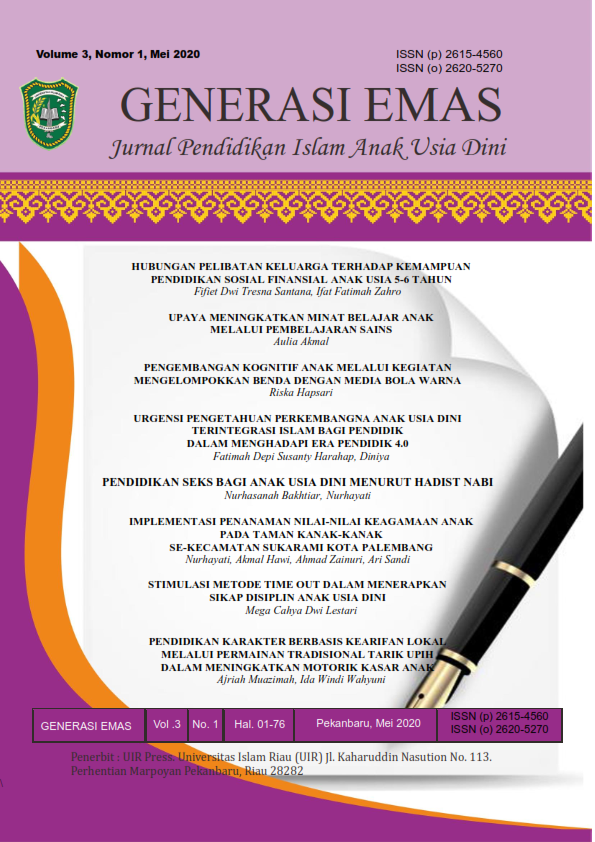STIMULASI METODE TIME OUT DALAM MENERAPKAN SIKAP DISIPLIN ANAK USIA DINI
DOI:
https://doi.org/10.25299/jge.2020.vol3(1).5385Abstract
The time out method is effective in stimulating discipline in early childhood. The success factor of the time-out method can be found in the age difference that causes different stages of development in each child which includes cognitive development, moral development, discipline, and the consistent role of parents and teachers in the implementation of the correct time-out procedure, especially the provision of rewards following aim. Disciplinary education needs to be instilled in children from an early age that if children make mistakes they will certainly receive consequences, for this reason, the punishment function in children's education. Discipline is a behavioral value that can be done by force and can be done voluntarily. In early childhood, this form of discipline must be implemented voluntarily and through play. Teachers, the community, and parents are the most influential factors in disciplining children.
Downloads
References
Anggia, Y. (2015). Time Out dalam Parenting Mengasuh Anak itu Mudah dan Menyenangkan. Jakarta: Esensi Erlangga Grup.
Di Fabio, C. (2003). Pitture, Oreficerie, dan Mercato Tra Mewah Genova dan Spagna fra XII dan XIV Secolo.
Edi, P. (2012). Modifikasi Perilaku (Alternatif Penanganan Anak Berkebutuhan Khusus). Yogyakarta: Pustaka Pelajar.
Hurlock, E. B., Istiwidayanti, Sijabat, R. M., & Soedjarwo. (1990). Psikologi Perkembangan: Suatu Pendekatan Sepanjang Rentang Kehidupan. Erlangga, Jakarta: Penerbit Erlangga.
Mansur, M. A. (2005). Pendidikan Anak Usia Dini dalam Islam. Yogyakarta: Pustaka Pelajar.
Martin, G., & Pear, J. J. (2015). Behavior modification: What it is and how to do it. Psychology Press. New Jersey: Pearson
Miltenberger, R. G. (2011). Behavior Modification: Principles and Procedures. Cengage Learning. USA : Wadsworth
Nasional, D. P. (2003). Undang-Undang Nomor 20 Tahun 2003 Tentang Sistem Pendidikan Nasional. Jakarta.
Nazir, M. (2005). Metodologi Penelitian (Research Methodology). Bogor: Ghalia Indonesia.
Nurhayati, E. (2016). Psikologi Pendidikan Inovatif. Pustaka Pelaiar.
Purwanta, E. (2014). Pengembangan Model Modifikasi Perilaku Terintegrasi Program Pembelajaran untuk Anak dengan Masalah Perilaku. Jurnal Cakrawala Pendidikan, 33(2).
Safaria, T. (2005). Autisme: Pemahaman Baru untuk Hidup Bermakna bagi Orang Tua. Yogyakarta: Graha Ilmu.
Severe, S. (2001). Bagaimana Bersikap pada Anak agar Anak Bersikap Baik: Berdasarkan Kisah-kisah dari para Orangtua yang punya Masalah dalam Membesarkan Anaknya. Jakarta: Gramedia Pustaka Utama.
Spiegler, M. D. (86). Guevremont, DC (2003). Contemporary Behavior Therapy (4th ed.). Belmont, CA: Wadsworth, 8.
Suyanto, S. (2005). Dasar-dasar Pendidikan Anak Usia Dini. Yogyakarta: Hikayat Publishing.
Zed, M. (2004). Metode Peneletian Kepustakaan. Yayasan Obor Indonesia.











